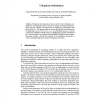Free Online Productivity Tools
i2Speak
i2Symbol
i2OCR
iTex2Img
iWeb2Print
iWeb2Shot
i2Type
iPdf2Split
iPdf2Merge
i2Bopomofo
i2Arabic
i2Style
i2Image
i2PDF
iLatex2Rtf
Sci2ools
INTERACT
2007
2007
Ubiquitous Substitution
Abstract. Ubiquitous interaction places the user in the centre of dynamic configurations of technology, where work not necessarily is performed through a single personal computer, but supported by a multiplicity of technologies and physical devices. This paper presents an activity-theoretically based framework for analyzing ubiquitous substitution, i.e. a set of mediators that are or can be continuously substituted with the purpose of highlighting expected and indented uses, and the conflicts encountered when attempting substitution between them. The paper develops a four-leveled analysis of such mediators, and point towards a minimalist approach to design of ubiquitous interaction.
Human Computer Interaction | INTERACT 2007 | Single Personal Computer | Ubiquitous Interaction | Ubiquitous Substitution |
| Added | 29 Oct 2010 |
| Updated | 29 Oct 2010 |
| Type | Conference |
| Year | 2007 |
| Where | INTERACT |
| Authors | Christina Brodersen, Susanne Bødker, Clemens Nylandsted Klokmose |
Comments (0)

